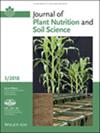Metabolic and transcriptomic effects of Aphanothece sp. biostimulant on tomato plant growth and phosphorus acquisition
Abstract
Background
Phosphorus (P) fertilizers, made from rock phosphate, increase crop yields. However, rock phosphate is a finite resource, stressing the need for more P-efficient crops.
Aims
This study aims to exploit P-adaptive traits that enhance P-acquisition and P-use efficiency in crops, as a potential sustainable P-use management method in agricultural settings.
Methods
This study investigates the biostimulant effects of Aphanothece sp. extracts (ApE) on P absorption efficiency traits of tomato plants supplied with triple super phosphate fertilizer (0.3, 0.6, and 1.2 mM Pi).
Results
ApE extracts exhibited significant effects on P uptake, Lycopersicum esculentum high-affinity phosphate transporter (LePT) genes, chlorophyll, and lipid contents, compared with control plants. ApE significantly enhanced leaf LePT4 in ApE-treated plants supplied with 0.3 mM Pi, and root LePT2 in ApE-treated plants supplied with 0.6 mM Pi. According to principal component analysis, P concentration in roots (root Pi) was closely associated with root dry weight (DW), root LePT2, and leaf LePT4. The phytohormone, gibberellin gibberellic acid 4, slightly correlated with root Pi, LePT2 (0.18), LePT4 (0.28), and more with root (0.72) and shoot DW (0.60), whereas abscisic acid correlated with chlorophyll content (0.60), LePT2 (0.50), and LePT4 (0.49), and slightly with root Pi (0.22). Gas chromatography–mass spectrometry analysis also showed that the application of ApE to plants stimulated the biosynthesis of several metabolites. The metabolic pathway analysis using MetaboAnalyst revealed that ApE treatment induced the unsaturated fatty acid, steroid, cutin, suberin, and wax biosynthesis pathways.
Conclusions
ApE application to tomato plants stimulated P uptake by roots through enhanced expression of high-affinity P transporters (root LePT2 and leaf LePT4), positively correlated with root DW and root Pi. The study also suggests that algal extracts stimulate plant growth through improved P uptake and modulate the plant's metabolic pathways that favor crop performance in tomato plants under normal Pi conditions.



 求助内容:
求助内容: 应助结果提醒方式:
应助结果提醒方式:


